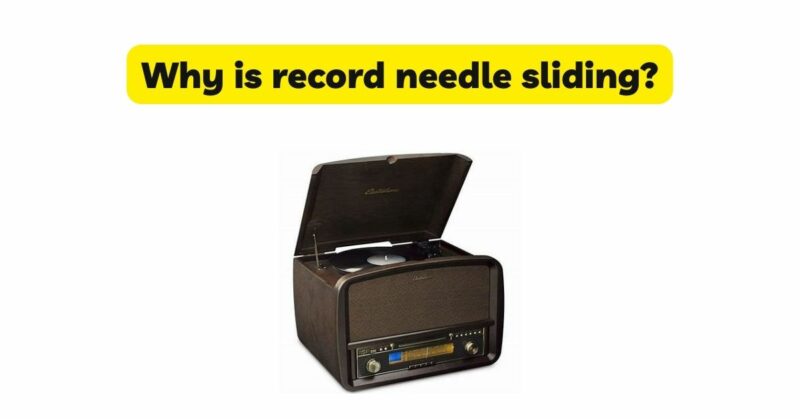Record needle sliding, also known as needle skip or skating, can be a frustrating experience for vinyl enthusiasts. This phenomenon occurs when the needle momentarily loses contact with the groove and skips forward or backward, disrupting the smooth playback of the record. In this article, we will delve into the various factors that contribute to needle sliding, including tracking force, anti-skate settings, record condition, and turntable setup. By understanding the reasons behind needle sliding, we can take steps to address and minimize this issue, enhancing our vinyl listening experience.
- Tracking Force: One of the primary factors contributing to needle sliding is an incorrect or insufficient tracking force. Tracking force refers to the downward pressure exerted on the stylus as it tracks the record’s grooves. If the tracking force is too light, the stylus may not maintain proper contact with the grooves, leading to momentary loss of tracking and needle sliding. Conversely, excessive tracking force can cause the stylus to dig too deeply into the grooves, increasing the risk of skipping.
- Anti-Skate Settings: Anti-skate settings on a turntable help counteract the inward force that pulls the stylus toward the center of the record due to the angular momentum of the spinning platter. Incorrect or improperly adjusted anti-skate settings can result in uneven forces acting on the stylus, leading to skating issues. When the anti-skate force is not properly balanced, the stylus may slide and skip across the record.
- Record Condition: The condition of the record itself can significantly influence needle sliding. Records with visible damage, such as scratches, warps, or manufacturing defects, can cause the stylus to momentarily lose contact with the grooves. Imperfections in the groove surface can create disruptions in the stylus’s path, leading to sliding or skipping.
- Tonearm Setup and Alignment: The setup and alignment of the turntable’s tonearm play a crucial role in preventing needle sliding. A misaligned or improperly calibrated tonearm can introduce lateral forces that cause the stylus to move erratically within the groove. Proper alignment ensures that the stylus tracks the grooves accurately, minimizing the risk of sliding.
- Stylus Condition: The condition of the stylus itself is another important factor to consider. A worn or damaged stylus can result in compromised tracking performance, leading to increased needle sliding. Over time, the tip of the stylus can wear down, affecting its ability to maintain consistent contact with the grooves. Regular stylus inspection and replacement are essential for optimal playback and to minimize the risk of sliding.
- Turntable Suspension and Isolation: The suspension and isolation mechanisms of a turntable contribute to the stability and vibration control necessary for accurate tracking. Inadequate turntable suspension or inadequate isolation from external vibrations can introduce unwanted movement that affects the stylus’s ability to track the grooves smoothly. Upgrading to a better-isolated turntable or implementing additional isolation measures can help minimize needle sliding.
- Dust and Debris: The presence of dust, debris, or static electricity on the record surface can interfere with stylus tracking, leading to needle sliding. Dust particles can create small obstacles that disrupt the contact between the stylus and the grooves. Regular cleaning of both the stylus and the records helps minimize the accumulation of debris and maintain optimal playback conditions.
- Record Weight and Thickness: Certain records, particularly lightweight or thin pressings, may be more prone to needle sliding. These records may have less mass and stability, making it easier for external forces, such as vibrations or changes in tracking force, to cause the stylus to lose contact with the grooves. Adjusting the tracking force or using a record weight or clamp can help improve stability and reduce sliding issues.
- Playing Technique: The way records are handled and played can also affect needle sliding. Rough handling, abrupt movements, or incorrect lowering and lifting of the tonearm can introduce additional lateral forces on the stylus, increasing the risk of sliding. Gentle and careful handling of the turntable and tonearm is crucial for maintaining consistent stylus contact with the grooves.
- Room Acoustics and Placement: Room acoustics and the placement of the turntable within the listening environment can indirectly affect needle sliding. Excessive vibrations, uneven surfaces, or proximity to speakers or other sources of vibration can introduce unwanted movement and impact stylus tracking. Proper turntable placement on a stable surface and consideration of room acoustics can help minimize external influences on needle sliding.
Conclusion: Needle sliding during vinyl playback can be a frustrating interruption to the listening experience. Understanding the factors that contribute to needle sliding allows us to address and mitigate the issue effectively. Adjusting tracking force, fine-tuning anti-skate settings, maintaining clean records and stylus, ensuring proper tonearm setup and alignment, and considering turntable suspension and isolation are key steps in reducing needle sliding. By implementing these measures, vinyl enthusiasts can enjoy uninterrupted playback, allowing the true beauty and fidelity ofthe music to shine through. Remember to handle records with care, create an optimal listening environment, and stay vigilant in maintaining the condition of both the records and the stylus. By addressing the causes of needle sliding, we can enhance our vinyl listening experience and fully immerse ourselves in the captivating world of analog sound.

